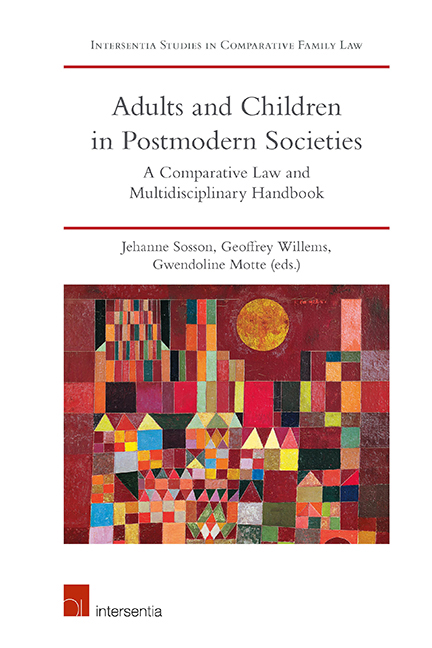Book contents
- Frontmatter
- Contents
- List of Cases
- List of Contributors
- Introduction
- PART I NATIONAL REPORTS ON LEGAL REGULATIONS OF RELATIONSHIPS BETWEEN ADULTS AND CHILDREN
- Questionnaire
- Models
- Algeria
- Argentina
- Australia
- Belgium
- Canada
- Democratic Republic of the Congo
- England and Wales
- France
- Germany
- Ireland
- Italy
- Japan
- The Netherlands
- Romania
- Spain and Catalonia
- Sweden
- Switzerland
- United States of America
- PART II INTERDISCIPLINARY APPROACH
- PART III INTERNATIONAL LAW INSIGHTS
- PART IV COMPARATIVE APPROACH
- General Conclusion: The Challenge of Transparent and Inclusive Parenthood/Parentality in a Pluralist and Cosmopolitan Context
- About the Editors
Ireland
from PART I - NATIONAL REPORTS ON LEGAL REGULATIONS OF RELATIONSHIPS BETWEEN ADULTS AND CHILDREN
Published online by Cambridge University Press: 26 June 2019
- Frontmatter
- Contents
- List of Cases
- List of Contributors
- Introduction
- PART I NATIONAL REPORTS ON LEGAL REGULATIONS OF RELATIONSHIPS BETWEEN ADULTS AND CHILDREN
- Questionnaire
- Models
- Algeria
- Argentina
- Australia
- Belgium
- Canada
- Democratic Republic of the Congo
- England and Wales
- France
- Germany
- Ireland
- Italy
- Japan
- The Netherlands
- Romania
- Spain and Catalonia
- Sweden
- Switzerland
- United States of America
- PART II INTERDISCIPLINARY APPROACH
- PART III INTERNATIONAL LAW INSIGHTS
- PART IV COMPARATIVE APPROACH
- General Conclusion: The Challenge of Transparent and Inclusive Parenthood/Parentality in a Pluralist and Cosmopolitan Context
- About the Editors
Summary
CHANGES IN THE TRADITIONAL FAMILY
A. MOTHERS
1. Is maternity automatically established by the birth certificate?
Yes. The woman who gives birth to a child is recorded as the child's mother on the birth certificate and is the child's legal mother and guardian.
2. Does your jurisdiction recognise any kind of ‘anonymous childbirth’?
No.
3.– 4. If any kind of ‘anonymous childbirth’ is recognised, what rights does the natural mother have in respect of the child? / In the same situation, what are the child's rights in respect of the natural mother (and her other children)?
Not applicable under Irish Law.
B. FATHERS
5. Is paternity automatically established by way of a presumption? If yes, does the presumption only apply within marriage?
Yes to both questions.
Section 46(1) of the Status of Children Act 1987 provides that where a child is born within marriage, or within 10 months of the termination of a marriage, the woman's husband is presumed to be the child's father.
Birth registration must take place no later than three months after the birth of the child. Where the child's parents are married, only one of them needs to attend the Registrar's office to register the birth of the child and the consent of the absent spouse is not necessary in order to enter their name as the mother/ father on the register of births.
6. If paternity is not established by way of a presumption, how can it be established?
Section 46(3) of the Status of Children Act 1987 provides that legal paternity is presumed by naming a man on the birth certificate. Even if it is unclear from the legislation, it applies whether or not the mother is married.
- Type
- Chapter
- Information
- Adults and Children in Postmodern SocietiesA Comparative Law and Multidisciplinary Handbook, pp. 323 - 350Publisher: IntersentiaPrint publication year: 2019



